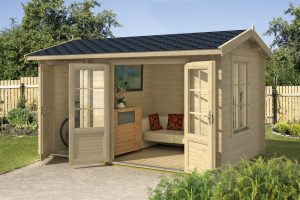 After all the planning, time, effort and expense of finding your perfect log cabin, the last thing you want is to encounter any problems.
After all the planning, time, effort and expense of finding your perfect log cabin, the last thing you want is to encounter any problems.
Having an understanding of what these are will give you a heads up and the opportunity to do what you can to nip them in the bud and prevent them from happening.
So what are the problems you may encounter?
- Wood Rot and Mould
- Log Settlement – Contraction and Expansion
- Cracking and Splitting of Timber
- UV Damage
- Wind Damage
- Insects
- Rodents
Wood Rot and Mould
Logs rot because of water. The timber becomes spongy and will look darker than the surrounding wood.
- Prolonged exposure to condensation and moisture over time will cause mould to grow on the timber
- High levels of moisture will cause the wood to decay and this will lead to wet rot
Water splashing from the ground onto the lower logs of the cabin is the number one cause of rotten logs.
The dank, dirty conditions at the bottom of the cabin are also prone to excessive moisture if it is too close to the ground. This creates the ideal environment for mould and decay to thrive.
In a nutshell – it’s important to keep the cabin dry
Recommendations to Keep the Cabin Dry and Prevent Rot
1. Maintain a good finish on the exterior logs
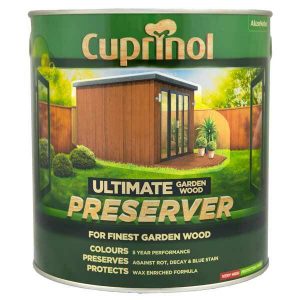 It’s vital to treat the cabin with a suitable treatment that:
It’s vital to treat the cabin with a suitable treatment that:
- repels water and condensation from the wood’s exterior surface
- allows the wood to breath – allowing the moisture inside the logs to make its way out
The logs should be treated as soon as possible after installation – ideally in the first week, or within a maximum of 4-6 weeks:
- Firstly with wood preservative, and then
- 2-3 coats of good quality paint or stain
and regularly thereafter every couple of years.
*Recommendation* – Cuprinol Wood Preserver
- Ensure the timber is thoroughly covered, including all the sides and edges of the eaves and apex fascia boards
- Doors and windows must be painted on every surface, including the window battens, to prevent swelling and warping
- It’s a good idea to treat the floor and roof boards before the cabin is installed:
- Protects the underside of the floorboards from rising damp and prevent any damp from penetrating the boards
- Roof coverings, ie. felt or shingles, will protect the roof from rainwater however the roof boards need treating to prevent air moisture getting into them which can cause swelling and lifting in areas of high humidity
Remember to treat the interior walls of your cabin as moisture can build up inside.
See my blog How to Treat a Log Cabin for advice.
2. Guttering
It’s important to keep the water that splashes off the roof to a minimum.
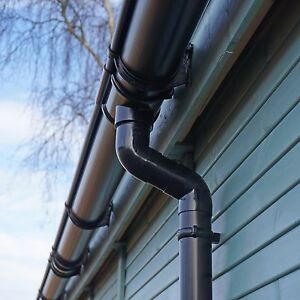 By installing guttering, this will:
By installing guttering, this will:
- Reduce the amount of water exposure and backsplash onto the cabin walls from rain falling from the roof
- Redirect the water well away from the wall logs, windows, doors and foundations
- Help protect the treatment of the cabin by preventing the wall logs from deteriorating significantly faster from continuous contact with rainwater
Ideally don’t position the cabin under trees to avoid leaves and debris falling on to the roof and blocking the guttering.
If this is not possible, a mesh cover on top of your gutters will help keep the debris out and continue to allow rainwater to filter through.
See my blog How to Install Guttering on a Log Cabin for advice.
3. Clear soil and other debris from around the bottom of the cabin
Ground cover, soil and mulch should be at least 3 feet from the bottom of the cabin.
- This will keep excess water and debris away from the walls which will help prevent mould
Make sure the soil slopes down from the cabin to promote adequate drainage away from the foundation.
4. The base should be the same size as the footprint of the cabin
Opinions can vary on this, however the general consensus – and the one we agree with – is that the base should be the same size as the footprint of the cabin.
- If the base is larger, water will run off the cabin and gather, increasing the risk of water ingress
Choosing a cabin with large roof overhangs:
- Is a good way of reducing rainwater falling onto, and getting into, the logs
- Helps control water falling close to the base of the cabin and prevent backsplash
6. Pay attention to logs underneath windows
Water tends to concentrate on logs directly under windows which creates rot.
- Make sure the seal is complete – the seal between the bottom of the window and the top of the log needs to be tight
7. Raise the cabin above the surrounding ground
Ideally, the cabin should be built at the highest point in your garden.
However, if this is not possible, it is recommended the cabin is elevated at least two inches off the ground.
This will help prevent:
- Water splashing back from the roof onto the lower logs
- Tree roots, shrubs and moisture from the soil damaging the logs
Log Settlement – Contraction and Expansion
Following the construction of the cabin, there will be a period of ‘settling’ as the timber reacts and adjusts to the climate. This natural occurrence happens when the wood shrinks and settles.
The timber is constantly expanding and contracting as it tries to reach a moisture content balance with its surrounding environment. This is also caused by adverse weather conditions, especially when it is very cold or extremely hot.
This shrinking and shifting in the timber can create gaps that allow air and water to seep between the logs.
Contraction is particularly common in the summer when the air is warm and dry and humidity levels are low.
Recommendations to Deal with Problems Caused by
Contraction and Expansion
1. Storm braces
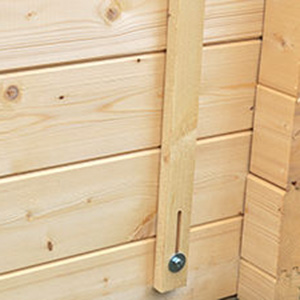 Most log cabins come with storm braces which are long battens of wood fixed at the top and bottom to the 4 corners of the cabin.
Most log cabins come with storm braces which are long battens of wood fixed at the top and bottom to the 4 corners of the cabin.
Storm braces can be adjusted to ensure any gaps in the logs are closed by loosening the bolts to allow the logs to settle.
They work by fixing the top wall logs to the bottom ones which are held down by the total weight of the cabin.
- Secure to the walls of the cabin at the top and bottom with a nut and bolt
- At the bottom is a slot for the bolt to go through which allows the storm bar to move up and down as the walls settle and then expand and contract
- It may be necessary to release the tension from the top bolt to allow the storm brace to move freely. This should be checked regularly throughout the life of your cabin to prevent gaps between the logs.
Click here for handy video: How to Install Storm Braces
2. Treat the cabin walls inside and out
See Maintain a good finish on the exterior logs section above.
Cracking and Splitting of the Logs
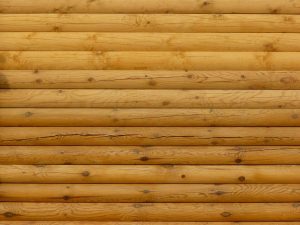 Due to its organic nature, cracks and splits are a normal occurence in timber as it tries to move, swell and shrink to match its environment.
Due to its organic nature, cracks and splits are a normal occurence in timber as it tries to move, swell and shrink to match its environment.
As the wood dries, the difference in surface tension and moisture gradients between the inner and outer parts of the logs over time causes cracks and splits.
These shouldn’t, however, compromise the structure of your building.
Upward facing cracks can collect water and allow it to travel deep into the logs which can eventually result in internal wood decay. This is a problem associated with American style, round timber log cabins and very rarely occurs in garden cabins sold in the UK but is still worth a mention.
Recommendations to Deal with Cracks and Splits
1. Use an external sealant
Fill in cracks and splits with a matching flexible sealant.
*Recommendation* – Woodsman Wood Sealant
2. Ensure the base is level and flat
If the base isn’t level, the cabin will settle into the flaws, the logs won’t seat properly and the roof boards won’t attach to the cabin straight. This can lead to problems such as warping, cracking and splitting of the wood.
UV Damage
Harsh UV (ultraviolet) rays can cause cellular damage and break down the surface of the wood causing it to weaken, change colour and become a food source for micro fungi which eventually causes it to rot.
Recommendations to Help Against UV Damage
1. Pigmented stains and treatments infused with UV combatants
- UV protection from these treatments helps and protects the surface of the wood by reflecting the harmful radiation
The cabin should be re-treated every couple of years.
See my blog How to Treat a Log Cabin for advice.
2. Roof overhangs
They create shade which reduces the sun’s exposure on the cabin.
3. Position the cabin with trees on the south and west side
They help provide shade and reduce sun exposure.
Wind/Storm Damage
In exposed areas in particular cabins can be susceptible to wind damage.
Wind can have an abrasive effect on the wooden walls with dirt particles being blown against them throughout the year and this can contribute to the cracking of the timber.
Recommendations to Help Against Wind/Storm Damage
1. Storm braces
They give extra support to the cabin during high winds. They protect it from damage and help prevent the roof being lifted – please note they cannot prevent damage to a cabin in very strong winds.
See Log Settlement above for details on how to fit storm braces.
2. Position the cabin with trees on the south and west side
Good for protection against strong winds.
3. Treat the cabin walls
See Maintain a good finish on the exterior logs above.
Insects
Dry spots in cabins, ie. door frames, logs, roof voids, eaves, together with any cracks, holes and crevices, are the perfect home for insects.
A majority of insects like rotting wood for nesting or food source.
Recommendations to Help Prevent Insects
1. Fill any obvious entry points or cracks and holes with flexible sealant
2. Ensure all the cabin is treated with wood preserver to prevent rot
3. Regularly inspect the cabin areas that show signs of wood decay
4. Keep it clean and maintained
Rodents
Rats and mice love covered areas and underneath a log cabin is ideal.
Recommendations to Help Prevent Rodents
1. Keep vegetation away from the sides of the cabin
These are perfect places for rodents to live.
2. Do not use ground feed for birds near the cabin
3. Avoid vegetable patches near the cabin
Both bird feed and vegetable patches are tempting food sources that can attract rodents and are a sure way of encouraging them to live under the cabin!
4. Check the cabin regularly for any obvious entry points
Rats and mice can squeeze into some really small places so look out for these and fill with flexible sealer – larger openings can be covered with wire mesh.

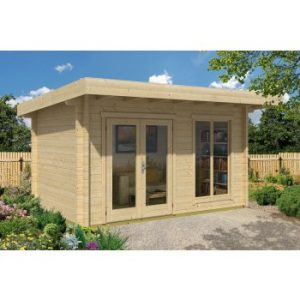
Great Blog! Thanks for sharing these tips and recommendations with log cabins.
Wrexham 2
Any tips on how to get a slightly twisted/warped 007 on row 18 – front elevation above front window/door frames, seems to be seated either end within the groves seating but proud in the middle section between garden shed wall and outer wall
Is there a way of twisting and pulling downwards – not sure it popped out overnight, as did not observe it when completed the side/s elevations on the Saturday. I haven’t installed the roofing yet, but I need to get weather tight as soon as possible and wanted to install roof boards and felt
Any tips, any wood pulling mechanism I can use to help get it into the slots.
Other than that it has gone together reasonably easy and quick.
Many regards
PaulBu
Hi Paul. I am very sorry for the issues you have had with your Wrexham cabin. I have contacted the technical chap at our suppliers for his advice on this and I will email you with his response as soon as I hear from him. Kind regards Jo